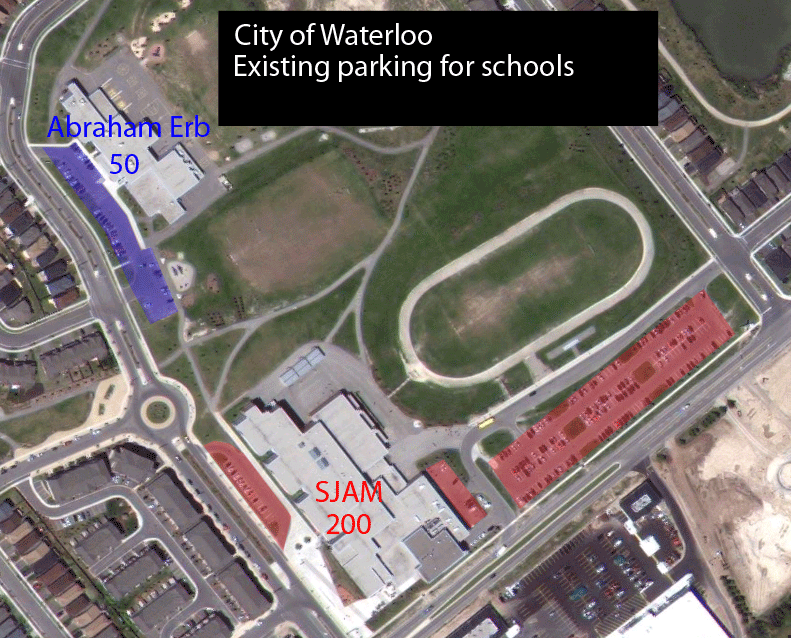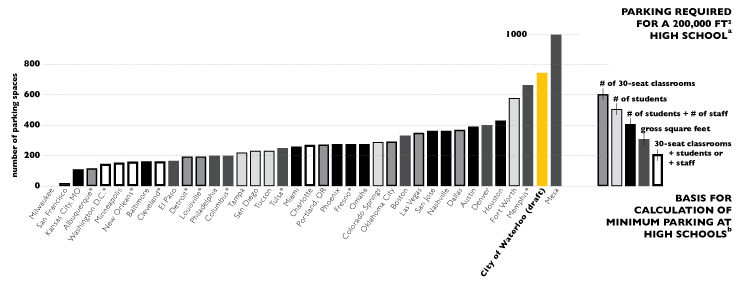Part 3 in a week-long series on parking in the City of Waterloo draft zoning bylaw.
Update: we have heard that staff have admitted an error in the draft bylaw and are reviewing the proposed parking requirements for schools.
Kids can’t drive. So why should schools need more parking than a shopping mall?
The current City of Waterloo zoning bylaws require 2 parking spaces per teaching area when a new school is built. But the proposed draft bylaw changes up the formula, requiring 4 parking spaces for every 100 square metres of floor space, plus an extra 5 spaces for visitors parking [1], which is more than what the City requires of Conestoga Mall.
It’s hard to compare these two figures directly, since we don’t have exact figures on how floor space relates to number of classrooms. But we were able to look at parking at existing schools, counting parking spaces on Google Maps and estimating from their building footprint and number of floors how many parking spaces the new bylaw would require if they were being built today.
We found that the draft bylaw could mean that most new or expanded schools could require more than 3 times as much parking as they currently have!

If Sir John A. Macdonald Secondary School and Abraham Erb Public School were built under the proposed zoning bylaw, they’d have to build over 3 times as much parking as they currently have.
This difference should alarm our school board trustees, as it could increase the costs of new elementary schools by roughly $1 million, and high schools by $5 million. What might be reduced in size to spare a few parking spaces or be compromised to help pay for this added expense? Smaller playgrounds and gymnasiums, tighter classrooms, or fewer learning facilities?
In central areas, where Waterloo is expecting to see the most growth due to provincial policy and light rail, land will be expensive. The burden of building an expensive parking lot will be yet another reason for schools boards to avoid building schools in these core neighbourhoods, instead locating them too far away to walk or bike.
The implications that excess parking could have on children’s safety and transportation choices could be staggering. Already, parents dropping their kids off at school by car is a chronic problem, making walking or biking to school more dangerous than it needs to be. School boards and our cities are trying to find ways to discourage the practice, and get kids travelling to school actively. Expanded parking lots will work counter to this goal, not only by pushing new schools out to the fringes of town, but also by effectively inviting parents to drive in and park in an underused lot.

Draft school parking requirements for City of Waterloo compared against zoning bylaws of several US cities. Original chart from Graphic Parking by Seth Goodman.
We should give the school parking rules in the zoning bylaw a failing grade, and ask City staff to re-submit.
Tomorrow, we look at parking requirements in employment areas, which surprisingly are lower than those for schools.
Take action:
Write to the Zoning Bylaw Review staff and your city councillors, and let them know you are concerned about the enormous parking requirements for schools in the City of Waterloo’s next zoning bylaw.
Editor’s note: This post is part of a blog series on parking requirements in the City of Waterloo’s Zoning Bylaw Review. Read the other articles in this series:
- Part 1: Can the City of Waterloo move beyond parking minimums?
- Part 2: Housing and parking minimums – or why the rent is too damn high
- Part 4: Bigger parking lots for new workplaces?
- Part 5: Shared parking, reducing the burden on local businesses
- Part 7: The future of parking in Waterloo
[1] This same parking metric is applied to home daycares. Let that sink in a little. Home daycare. While licensed home daycares are limited to five children at a time, the zoning bylaw would require at minimum 5 visitors parking spaces, plus an additional 4 spaces for every 100 square metres occupied in the home. Not only is this entirely unrealistic for most places to accommodate, peak parking load is for mere minutes at the beginning and end of the work day, assuming it even approaches the minimum requirement. Almost all of this parking would sit empty during the rest of the day.
